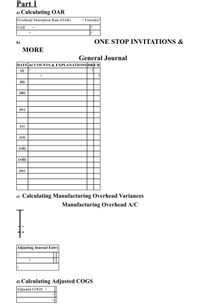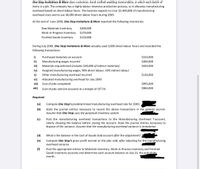
FINANCIAL ACCOUNTING
10th Edition
ISBN: 9781259964947
Author: Libby
Publisher: MCG
expand_more
expand_more
format_list_bulleted
Question
I need help
Answer the questions in the worksheet and fill in the blank space on the templates with the answers.

Transcribed Image Text:Part 1
a) Calculating OAR
Overhead Absorption Rate (OAR)
= Formula?
OAR
b)
ONE STOP INVITATIONS &
MORE
General Journal
DATE ACCOUNTS & EXPLANATIONS DR CR
(i) ?
?
(ii)
(iii)
(iv)
(v)
(vi)
(vii)
(viii)
(іx)
c) Calculating Manufacturing Overhead Variances
Manufacturing Overhead A/C
Adjusting Journal Entry
d) Calculating Adjusted COGS
Adjusted COGS =

Transcribed Image Text:One Stop Invitations & More does customize, hand-crafted wedding memorabilia, in which each batch of
items is a job. The company has a highly labour-intensive production process, so it allocates manufacturing
overhead based on direct labour hours. The business expects to incur $2,400,000 of manufacturing
overhead costs and to use 40,000 direct labour hours during 20X9.
At the end of June 20X9, One Stop Invitations & More reported the following inventories:
Raw Materials Inventory
$200,000
Work-in-Progress Inventory
$170,000
Finished Goods Inventory
$110,000
During July 20X9, One Stop Invitations & More actually used 3,000 direct labour hours and recorded the
following transactions.
i)
Purchased materials on account
$310,000
ii)
Manufacturing wages incurred
$400,000
iii)
Materials requisitioned (includes $30,000 of indirect materials)
$420,000
iv)
Assigned manufacturing wages, 90% direct labour, 10% indirect labour
v)
Other manufacturing overhead incurred
$130,000
vi)
Allocated manufacturing overhead for July 20X9
vii)
Cost of jobs completed
$995,000
viii)
Cost of jobs sold (on account) at a margin of 333%
$960,000
Required:
(a)
Compute One Stop's predetermined manufacturing overhead rate for 20X9.
(b)
State the journal entries necessary to record the above transactions in the general journal.
Assume that One Stop uses the perpetual inventory system.
(c)
Post the manufacturing overhead transactions to the Manufacturing Overhead T-account,
clearly showing the balance before closing the account. State the journal entries necessary to
dispose of the variance. Assume that the manufacturing overhead variance is immaterial.
(d)
What is the balance in the Cost of Goods Sold account after the adjustment?
(e)
Compute One Stop's gross profit earned on the jobs sold, after adjusting for the manufacturing
overhead variance
(f)
Post the appropriate entries to Materials Inventory, Work-in-Process Inventory and Finished
Goods Inventory accounts and determine each account balance on July 31, the end of the
month.
Expert Solution
This question has been solved!
Explore an expertly crafted, step-by-step solution for a thorough understanding of key concepts.
Step by stepSolved in 5 steps with 5 images

Knowledge Booster
Learn more about
Need a deep-dive on the concept behind this application? Look no further. Learn more about this topic, accounting and related others by exploring similar questions and additional content below.Similar questions
- Kindly use PMT in your computationsarrow_forwardCAN I SEE THE MANUAL WORKING OF THE PROBLEMarrow_forwardEducate these stakeholders on the advantages of utilizing a spreadsheet solution and how simple it was to process data in order to generate the information provided in the report in Excelarrow_forward
- Create a code in java to calculate the surface area and volume of a cylinder. You need to get the radius input from the userarrow_forwardcan you show the steps on a calculator ?arrow_forwardCan you further explain this to me to better understand the concept on what I'm supposed to do and what formulas I need to apply.arrow_forward
- Fill out the missing columns and show the calculation and formulasarrow_forwardWill you please provide the formulas (explanation) to understand the results or numbers that were added in the solution?arrow_forwardis there a way to do this question with formulas and a calculator instead of excel? if so please upload the solution this wayarrow_forward
arrow_back_ios
SEE MORE QUESTIONS
arrow_forward_ios
Recommended textbooks for you

 AccountingAccountingISBN:9781337272094Author:WARREN, Carl S., Reeve, James M., Duchac, Jonathan E.Publisher:Cengage Learning,
AccountingAccountingISBN:9781337272094Author:WARREN, Carl S., Reeve, James M., Duchac, Jonathan E.Publisher:Cengage Learning, Accounting Information SystemsAccountingISBN:9781337619202Author:Hall, James A.Publisher:Cengage Learning,
Accounting Information SystemsAccountingISBN:9781337619202Author:Hall, James A.Publisher:Cengage Learning, Horngren's Cost Accounting: A Managerial Emphasis...AccountingISBN:9780134475585Author:Srikant M. Datar, Madhav V. RajanPublisher:PEARSON
Horngren's Cost Accounting: A Managerial Emphasis...AccountingISBN:9780134475585Author:Srikant M. Datar, Madhav V. RajanPublisher:PEARSON Intermediate AccountingAccountingISBN:9781259722660Author:J. David Spiceland, Mark W. Nelson, Wayne M ThomasPublisher:McGraw-Hill Education
Intermediate AccountingAccountingISBN:9781259722660Author:J. David Spiceland, Mark W. Nelson, Wayne M ThomasPublisher:McGraw-Hill Education Financial and Managerial AccountingAccountingISBN:9781259726705Author:John J Wild, Ken W. Shaw, Barbara Chiappetta Fundamental Accounting PrinciplesPublisher:McGraw-Hill Education
Financial and Managerial AccountingAccountingISBN:9781259726705Author:John J Wild, Ken W. Shaw, Barbara Chiappetta Fundamental Accounting PrinciplesPublisher:McGraw-Hill Education


Accounting
Accounting
ISBN:9781337272094
Author:WARREN, Carl S., Reeve, James M., Duchac, Jonathan E.
Publisher:Cengage Learning,

Accounting Information Systems
Accounting
ISBN:9781337619202
Author:Hall, James A.
Publisher:Cengage Learning,

Horngren's Cost Accounting: A Managerial Emphasis...
Accounting
ISBN:9780134475585
Author:Srikant M. Datar, Madhav V. Rajan
Publisher:PEARSON

Intermediate Accounting
Accounting
ISBN:9781259722660
Author:J. David Spiceland, Mark W. Nelson, Wayne M Thomas
Publisher:McGraw-Hill Education

Financial and Managerial Accounting
Accounting
ISBN:9781259726705
Author:John J Wild, Ken W. Shaw, Barbara Chiappetta Fundamental Accounting Principles
Publisher:McGraw-Hill Education